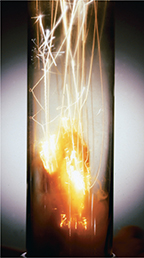Figure 21 At room temperature, chlorine is a gas, bromine is a liquid, and iodine is a solid. Halogens react easily with metals, such as the iron in steel wool. At a swimming pool, the chlorine content must be tested frequently. Applying Concepts What process causes iodine vapor to collect in a flask of solid iodine?

Chlorine reacting with steel wool

The Halogens
The elements in Group 7A are called halogens. Each halogen has seven valence electrons. Figure 21 shows the range of physical properties among the halogens. Fluorine and chlorine are gases, bromine is a liquid that evaporates quickly, and iodine is a solid that sublimes.
 Despite their physical differences, the halogens have similar chemical properties. They are highly reactive nonmetals, with fluorine being the most reactive and chlorine a close second. Halogens react easily with most metals. Figure 21 shows what happens when heated steel wool is plunged into chlorine.
Despite their physical differences, the halogens have similar chemical properties. They are highly reactive nonmetals, with fluorine being the most reactive and chlorine a close second. Halogens react easily with most metals. Figure 21 shows what happens when heated steel wool is plunged into chlorine.
Recall that a fluorine compound is used to prevent tooth decay. If you use pans with a nonstick coating to make omelets or muffins, you have seen another use of a fluorine compound. Have you ever noticed a sharp smell when adding bleach to a load of clothes? The smell comes from a small amount of chlorine gas that is released from a chlorine compound in the bleach. Chlorine is also used to kill bacteria in drinking water and swimming pools. The woman in Figure 21 is testing the level of chlorine in a swimming pool.
Your body needs iodine to keep your thyroid gland working properly. This gland controls the speed at which reactions occur in your body. Seafood is a good source of iodine. At a time when fresh fish was not available in all parts of the United States, people began to add iodine compounds to table salt. Salt that contains such compounds is called iodized salt.




